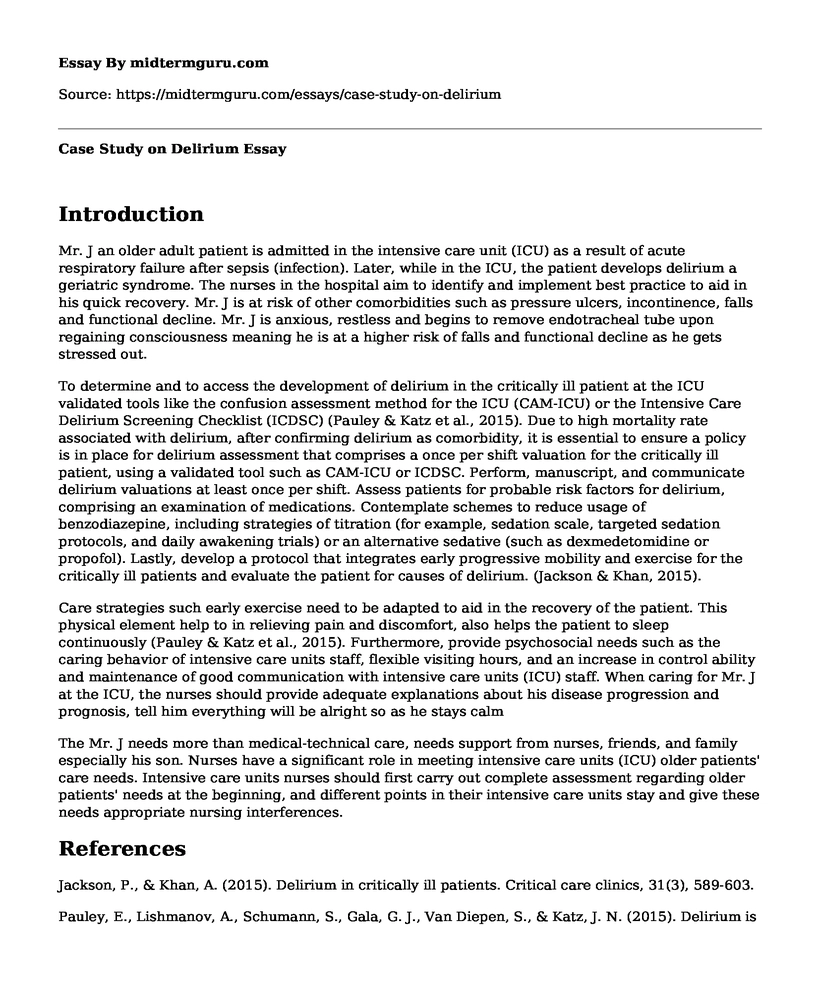Introduction
Mr. J an older adult patient is admitted in the intensive care unit (ICU) as a result of acute respiratory failure after sepsis (infection). Later, while in the ICU, the patient develops delirium a geriatric syndrome. The nurses in the hospital aim to identify and implement best practice to aid in his quick recovery. Mr. J is at risk of other comorbidities such as pressure ulcers, incontinence, falls and functional decline. Mr. J is anxious, restless and begins to remove endotracheal tube upon regaining consciousness meaning he is at a higher risk of falls and functional decline as he gets stressed out.
To determine and to access the development of delirium in the critically ill patient at the ICU validated tools like the confusion assessment method for the ICU (CAM-ICU) or the Intensive Care Delirium Screening Checklist (ICDSC) (Pauley & Katz et al., 2015). Due to high mortality rate associated with delirium, after confirming delirium as comorbidity, it is essential to ensure a policy is in place for delirium assessment that comprises a once per shift valuation for the critically ill patient, using a validated tool such as CAM-ICU or ICDSC. Perform, manuscript, and communicate delirium valuations at least once per shift. Assess patients for probable risk factors for delirium, comprising an examination of medications. Contemplate schemes to reduce usage of benzodiazepine, including strategies of titration (for example, sedation scale, targeted sedation protocols, and daily awakening trials) or an alternative sedative (such as dexmedetomidine or propofol). Lastly, develop a protocol that integrates early progressive mobility and exercise for the critically ill patients and evaluate the patient for causes of delirium. (Jackson & Khan, 2015).
Care strategies such early exercise need to be adapted to aid in the recovery of the patient. This physical element help to in relieving pain and discomfort, also helps the patient to sleep continuously (Pauley & Katz et al., 2015). Furthermore, provide psychosocial needs such as the caring behavior of intensive care units staff, flexible visiting hours, and an increase in control ability and maintenance of good communication with intensive care units (ICU) staff. When caring for Mr. J at the ICU, the nurses should provide adequate explanations about his disease progression and prognosis, tell him everything will be alright so as he stays calm
The Mr. J needs more than medical-technical care, needs support from nurses, friends, and family especially his son. Nurses have a significant role in meeting intensive care units (ICU) older patients' care needs. Intensive care units nurses should first carry out complete assessment regarding older patients' needs at the beginning, and different points in their intensive care units stay and give these needs appropriate nursing interferences.
References
Jackson, P., & Khan, A. (2015). Delirium in critically ill patients. Critical care clinics, 31(3), 589-603.
Pauley, E., Lishmanov, A., Schumann, S., Gala, G. J., Van Diepen, S., & Katz, J. N. (2015). Delirium is a robust predictor of morbidity and mortality among critically ill patients treated in the cardiac intensive care unit. American heart journal, 170(1), 79-86.
Cite this page
Case Study on Delirium . (2022, Sep 07). Retrieved from https://midtermguru.com/essays/case-study-on-delirium
If you are the original author of this essay and no longer wish to have it published on the midtermguru.com website, please click below to request its removal:
- Paper Example on Nutrition
- The Effects and Benefits of Drugs on Society - Paper Example
- The Health Problem for the Population - Paper Example
- Research Paper on Nursing Leadership Health Policy
- IVF vs Spontaneous Pregnancies: Leiomyoma & Complications - Research Paper
- Affordable Healthcare: Todd and Reginald Case Study
- Conducting an RCA: Understanding Challenges & Taking Action - Research Paper







